Home » Gemstones » American Gemstones » Colorado
Colorado Gemstone Mining
Most people are surprised to learn that diamonds and many other gems have been mined in Colorado!
Author: Hobart M. King, PhD, GIA Graduate Gemologist
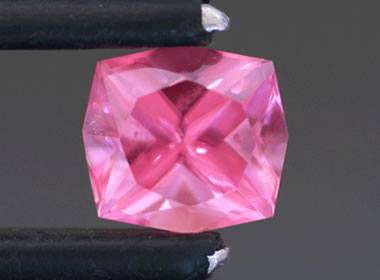
Colorado Rhodochrosite: Rhodochrosite is the official state mineral of Colorado. Sometimes, nice transparent specimens can be found that are suitable for cutting faceted stones. This faceted cushion was cut from material obtained from the famous Sweet Home Mine near Alma, Colorado. It has a nice orangish pink color, measures 6.7 x 6.2 millimeters and weighs 1.52 carats. Photo by Bradley Payne, TheGemTrader.com.
Colorado Gemstones
A wide variety of gems have been mined in Colorado. For a short time, Colorado had the only commercial diamond mine in North America. The state is also famous for its aquamarine, rhodochrosite, amazonite, smoky quartz, and other minerals. For some of these materials, gem-quality crystals are sought by both gem collectors and mineral specimen dealers - and that pushes up prices.
Table of Contents
 Colorado Rhodochrosite Colorado Rhodochrosite Colorado Aquamarine Colorado Aquamarine Amazonite and Smoky Quartz Amazonite and Smoky Quartz Colorado Diamonds Colorado Diamonds |
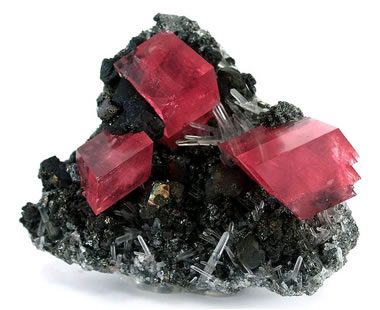
Colorado Rhodochrosite Crystals: Crystals of transparent red rhodochrosite on tetrahedrite with a few clear quartz crystals. This specimen is about 5 x 4 x 2 centimeters in size and was taken from the Sweet Home Mine. Crystals this transparent and of such wonderful color would make beautiful faceted stones, but because this is such a fine crystal specimen, there would be a huge financial loss if that were done. Specimen and photo by Arkenstone / www.iRocks.com
Colorado Rhodochrosite
The most famous locality in the world for superb rhodochrosite crystals is the Sweet Home Mine, located near the community of Alma, Colorado. It was opened in 1873 as a silver mine and was worked on and off for silver until the 1960s.
|
After the silver mining stopped, activity at the Sweet Home Mine focused on the beautiful red rhodochrosite. Ground-penetrating radar was used to locate cavities in the wall rock of the mine. Some of these cavities contained rhodochrosite crystal clusters that could be sold at retail for thousands of dollars each. Many of the rhombohedral crystal specimens produced at the mine are in museums, schools, and private collections around the world.
Some Sweet Home rhodochrosite is transparent enough to cut wonderful faceted stones (but don't do that to a great crystal specimen!). Translucent material is cut into beautiful cabochons of excellent color. These gems are best used in pendants, brooches, and earrings that will not be subject to impact or abrasion. Rhodochrosite is fragile. It has perfect cleavage in three directions and a Mohs Hardness of only 3.5 to 4.
The Sweet Home Mine is now closed, and material from that locality is very hard to get. There are a few other mines in Colorado that produce rhodochrosite; however, none of them are close to matching the quality of the Sweet Home Mine.
Hunt For Gems - Keep What You Find!There are over 100 mines in the United States where anyone can visit, pay a small fee, look for gems and minerals, and keep what they find. For a large list of these mines, visit our Fee Mining Page on RockTumbler.com. |
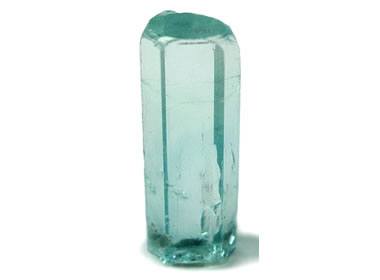
Colorado Aquamarine: Aquamarine is the official state gemstone of Colorado, and the most noted locality for finding the gem is the Mt. Antero area. This is a nice, clear, pale blue aquamarine crystal from Mount Antero, Colorado. It is about two centimeters tall and 0.7 centimeters in diameter. Specimen and photo by Arkenstone / www.iRocks.com
Colorado Aquamarine
Aquamarine, a gem variety of the mineral beryl, is the official state gemstone of Colorado. Serious prospecting for aquamarine began in the Mt. Antero area in the late 1800s. There, crystals of beryl ranging from water-clear goshenite to deep blue aquamarine can be found, along with a little yellow heliodor and pink morganite.
The best aquamarine finds on Mount Antero have been vugs in granite pegmatite exposed on the eastern side of the mountain at elevations over 12,000 feet. The vugs can contain from a few to a few thousand prismatic crystals. A good vug can contain $100,000 worth of aquamarine. If the crystals are mineral specimen quality or have the clarity and color of top-grade gems, the value can easily go a lot higher.
The challenges of looking for aquamarine on Mt. Antero are its altitude, weather, and remote location. At over 14,000 feet in elevation, the weather can be cold, and the aquamarine hunting season is limited to about three months of summer. Wind, lightning storms, and frequent afternoon rains can be life-threatening at low temperatures and high altitudes.
Mt. Antero has grown in popularity with gem hunters after being featured on television prospecting shows. Today there can be a few dozen claims at any given time on Mt. Antero, and visitors must be careful not to trespass on someone's claim. Many claim holders are very unfriendly to visitors because they have put in a lot of sweat and effort hoping to find a nice cavity of high-value gems.
In addition to Mt. Antero, a few other Colorado locations are known to yield nice aquamarine crystals. These include Mt. White, which is connected to Mt. Antero by a high saddle. Nice specimens are also found on Mt. Baldwin and Mt. Princeton, all peaks of over 12,500 feet and located nearby.
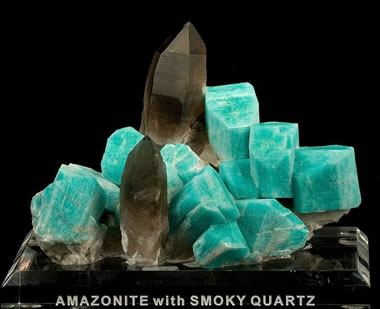
Colorado Amazonite and Smoky Quartz: Amazonite and smoky quartz could be the best-known gem mineral association found in Colorado. The beautiful blue-green amazonite contrasts sharply with the dark smoky quartz to make beautiful display specimens. Specimen and photo by Arkenstone / www.iRocks.com.
Colorado Amazonite and Smoky Quartz
If you go to a mineral show and see nice green amazonite crystals clustered with a couple crystals of smoky quartz, that specimen was probably collected in Colorado. The amazonite-smoky quartz clusters from Pikes Peak and a few other Colorado locations are very popular and often very valuable specimens. Other Colorado locations include Devil's Head, Pine Creek, Cheyenne, Crystal Park, and Harris Park. The crystals from these different areas are diverse in their shape, color, and associated mineral species.
Native Americans knew about amazonite. They made beads from the material to wear and trade. By the late 1800s, commercial ventures were mining the crystals and transporting them east for preparation and sale. The crystals were and continue to be produced from pockets in granite pegmatites. In the early 1900s, crystal collecting was popularized, and a number of fee mining sites were opened to the public.
The main demand for amazonite and smoky quartz from Colorado localities comes from mineral collectors, but some material still goes to lapidary use. Amazonite is a popular material to cut into cabochons, beads, and tumbled stones. Smoky quartz is sometimes faceted.
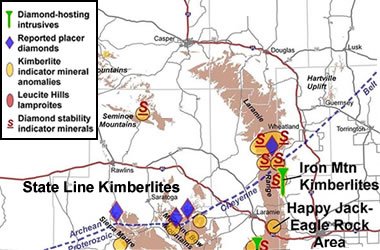
Diamond map of the Colorado-Wyoming border area: A small portion of a diamond exploration map published by the Wyoming State Geological Survey. WSGS has identified several hundred concentrations of kimberlite indicator minerals, indicative of possible nearby hidden diamond deposits. Image by Wyoming State Geological Survey.
Colorado Diamonds
The United States has two locations that operated as commercial diamond mines. One is the mine currently operated as a fee-mining site at Crater of Diamonds State Park in Arkansas. The other is the inactive Kelsey Lake Diamond Mine near Fort Collins, Colorado.
Over 100 kimberlites have been found in the Colorado-Wyoming state line area. They range in size from a few feet across to over 1/2 mile. Based upon bulk sampling done in the 1970s and 1980s, many of them contain diamonds, but their grades are only a carat or two per hundred metric tons, with the percentage of gem-quality stones being about 20%. This is too low to support a profitable mining operation.
The Kelsey Lake Mine opened in 1996 and began producing small amounts of diamonds, and it continued to operate until 2002 when the mine was closed because of legal problems. Most of the diamonds produced at the mine were clear, gem-quality stones. About one-third of the stones were one carat or larger in size. When the mine closed, there was an identified resource of 17 million tons of ore with an average grade of 4 carats per hundred metric tons. There is no indication that the mine will restart at any time soon or that another kimberlite will be developed.
| More Gemstones |
 |
Tourmaline |
 |
Fancy Sapphires |
 |
Diamond |
 |
Canadian Diamond Mines |
 |
Birthstones |
 |
Pictures of Opal |
 |
Fire Agate |
 |
Blue Gemstones |

Find Other Topics on Geology.com:

|

| ||

|

| ||

|

| ||

|

|
